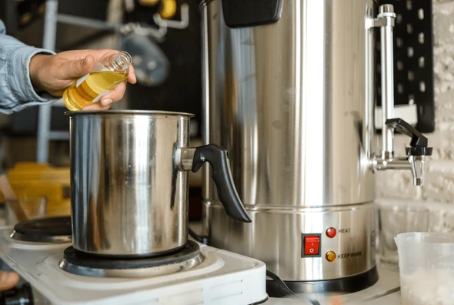Scented Candle Manufacturing: The Intersection of Art, Science, and Business

The creation of scented candles is an intricate process that blends art, science, and business acumen. From selecting the right ingredients to marketing the final product, manufacturers must navigate a complex landscape to deliver high-quality candles that resonate with consumers. This blog explores the multifaceted world of Scented candle manufacturer, highlighting the critical intersections of creativity, technical expertise, and strategic business decisions.
1. The Artistic Aspect: Crafting Unique Scented Candles
1.1. Fragrance Blending: The Heart of Scented Candles
The art of fragrance blending is central to the scented candle industry. A successful blend not only appeals to the senses but also tells a story. Master perfumers and candle makers often work together to create unique scents that evoke emotions, memories, or specific atmospheres. The process involves:
- Selecting Top, Middle, and Base Notes: These layers create a well-rounded fragrance. For example, a fresh summer candle might feature top notes of citrus, middle notes of floral scents, and base notes of musk or amber.
- Balancing the Scent Profile: Ensuring that the scent is not overwhelming but still strong enough to fill a room.
- Testing and Refining: Multiple iterations are often necessary to perfect the blend, ensuring that the fragrance remains consistent throughout the candle’s life.
1.2. Visual Aesthetics: Design and Presentation
The visual appeal of a candle is equally important. Manufacturers must consider:
- Color: The choice of wax color can enhance the sensory experience and align with the fragrance’s theme.
- Container Design: The container can range from minimalist glass jars to ornate ceramic pots, depending on the brand’s aesthetic.
- Labels and Packaging: These elements are crucial for brand identity and often include thoughtful design elements like typography, imagery, and textures.
1.3. Innovative Features
Modern candles often incorporate innovative features to stand out in the market. This can include:
- Dual or Triple Wicks: For an even burn and more light.
- Wood Wicks: Which offer a unique crackling sound.
- Special Effects: Such as color-changing wax or layered scents that evolve as the candle burns.
2. The Scientific Aspect: Ensuring Quality and Safety
2.1. Material Selection: Wax, Wick, and Additives
Choosing the right materials is a scientific endeavor that impacts the candle’s performance and safety. Key considerations include:
- Wax Types: Each type of wax, such as soy, paraffin, or beeswax, has different melting points, burn times, and scent throw capabilities. Manufacturers often choose waxes based on the desired characteristics of the final product.
- Wick Selection: The wick type affects the burn rate and flame stability. Cotton wicks are common, but wood wicks and other specialty wicks can provide unique experiences.
- Additives and Dyes: These are used to enhance the appearance and performance of candles. However, they must be carefully tested to ensure they do not affect the candle’s burn quality or safety.
2.2. Safety Standards and Testing
Ensuring the safety of scented candles is a critical aspect of manufacturing. This involves:
- Burn Testing: To check for an even burn, proper flame height, and minimal soot.
- Fragrance Load Testing: To ensure the scent is present but not overwhelming, and that it doesn’t cause irritation.
- Compliance with Regulations: Different regions have specific safety standards for candles, including flammability tests and restrictions on certain chemicals.
2.3. Sustainability and Eco-Friendly Practices
As consumers become more environmentally conscious, manufacturers are increasingly focusing on sustainable practices. This includes:
- Using Natural Waxes: Such as soy, beeswax, or coconut wax, which are biodegradable and renewable.
- Eco-Friendly Packaging: Recyclable containers and minimalistic packaging reduce environmental impact.
- Ethical Sourcing: Ensuring that materials, like essential oils or wax, are sourced from sustainable and ethical suppliers.
3. The Business Aspect: Navigating the Market
3.1. Market Research and Trend Analysis
Understanding market trends is essential for success in the scented candle industry. Manufacturers must:
- Identify Consumer Preferences: Analyzing market trends can reveal popular scents, packaging styles, and price points.
- Segment the Market: Targeting specific consumer demographics, such as luxury buyers, eco-conscious consumers, or niche markets like aromatherapy enthusiasts.
- Innovation and Differentiation: Staying ahead of competitors by offering unique products or experiences.
3.2. Branding and Marketing Strategies
A strong brand identity is crucial for standing out in a crowded market. This involves:
- Brand Storytelling: Communicating the brand’s values, mission, and unique selling points through various channels.
- Visual Identity: Consistent use of colors, fonts, and imagery that align with the brand’s message.
- Digital Marketing: Utilizing social media, influencer partnerships, and online advertising to reach a broader audience.
3.3. Distribution Channels
Choosing the right distribution channels can significantly impact a brand’s reach and sales. Options include:
- Direct-to-Consumer (DTC) Sales: Through a brand’s website or online marketplace, offering greater control over the customer experience.
- Wholesale: Partnering with retailers, boutiques, or large department stores to reach a wider audience.
- Subscription Boxes: Offering a curated experience with monthly or seasonal candle deliveries, providing steady revenue and customer engagement.
4. Challenges and Opportunities in the Scented Candle Industry
4.1. Supply Chain Management
Sourcing high-quality materials and ensuring consistent supply can be challenging, especially for natural ingredients. Manufacturers must build strong relationships with suppliers and have contingency plans for supply chain disruptions.
4.2. Competition and Market Saturation
The scented candle market is highly competitive, with numerous brands vying for consumer attention. Differentiating products through unique scents, high-quality materials, and compelling branding is crucial.
4.3. Evolving Consumer Preferences
Consumer preferences can shift rapidly, influenced by trends, economic factors, and cultural changes. Staying agile and responsive to these changes is key to maintaining relevance.
4.4. Technological Advancements
Technology offers new opportunities for innovation in candle manufacturing, from automation in production processes to digital tools for personalized customer experiences.
Conclusion
The intersection of art, science, and business in scented candle manufacturing creates a dynamic and multifaceted industry. From the artistry of fragrance blending and design to the scientific rigor of quality control and the strategic considerations of marketing and distribution, manufacturers must excel in multiple areas to succeed. As the market continues to evolve, those who can effectively integrate these elements will not only survive but thrive, crafting candles that delight consumers and stand the test of time.








